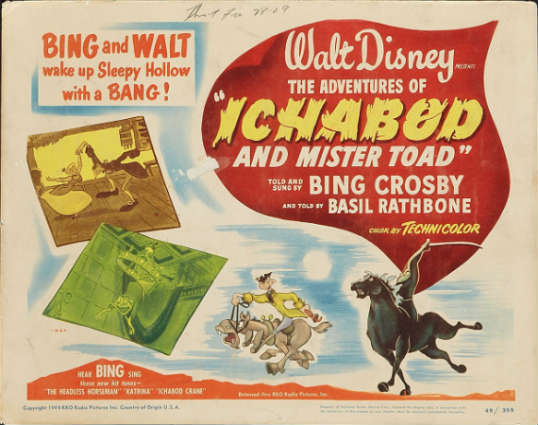
Welcome to Revisiting Disney! Today, we’re looking at the final anthology movie from that set of four that were made in the late 1940’s, The Adventures of Ichabod and Mr. Toad!
Of course, I have labeled each category so if you want to skip to the parts that interest you most, feel free. And if you have any thoughts, burning or otherwise, please share in the comments!
BACKGROUND
Like the last three films (Make Mine Music, Fun and Fancy Free and Melody Time), The Adventures of Ichabod and Mr. Toad is what the Disney Studio and most film historians tend to refer to as an anthology film. And like the last three films, it really got glossed over in all of the Disney Studio history texts that I have.
Bob Thomas, in his Disney’s Art of Animation from Mickey Mouse to Hercules, mentions the film in just two sentences; one of those sentences tells me that the Disney had been developing a full-length version of “The Wind in the Willows” before the War, a film that I would have loved to have seen. Adrian Bailey, in his Walt Disney’s World of Fantasy, treats Ichabod and Mr. Toad in the same manner; he just mentions that it happened.
Despite that, I was able to track down some information about this film. The Adventures of Ichabod and Mr. Toad combined the two animated shorts “The Wind in the Willows” and “The Legend of Sleepy Hollow,” similar to the way Fun and Fancy Free had been set up. Originally, it seems like both of these were going to be a full-length animated feature, but they were shelved due to budget restrictions and later put together in one film.
RELATED: Revisiting Disney: Fun and Fancy Free
This film was released in October of 1949, which is appropriate because both of the shorts are frightening. I remember watching “Sleepy Hollow” in particular at Halloween parties in elementary school and being terrified.
Now that I am older and wiser, I have to admit that both shorts are still kind of frightening. Like Fantasia and the “Night on Bald Mountain” sequence, Disney still receives complaints today about “The Legend of Sleepy Hollow,” and the Headless Horseman has been called one of the scariest Disney villains in the official canon.
MUSIC
The music in these two pieces is fun. Oliver Wallace provided the leadership as Musical Director while Ken Darby was responsible for the vocal arrangements and Joseph Dubin was responsible for the orchestration.
The music is fairly standard (for Disney) in that it is good at emotionally manipulating the audience without being too obvious about it. It is able to work with the animation to convey deeper emotions, and to lead us to how we should be feeling (in several cases in this film, that emotion is fear).
Part of what makes these two pieces memorable, I think, is the fact that “The Legend of Sleepy Hollow” segment is narrated and sung by iconic crooner Bing Crosby. This makes the music as memorable as if the Andrews Sisters had sung it, and also likely helped the film out in its day; Bing was kind of a big deal. Although this is pre-White Christmas (released in 1954 and where I know him from), Bing was still a household name as an iconic jazz singer.
RELATED: Julia’s Top 15 Christmas Movie Picks
ANIMATION
I loved the way the studio opened the film, by bringing us into a library where, first, Basil Rathbone (famous for playing Sherlock Holmes) introduced us to one of his favorite characters in British Literature, Mr. Toad. Opening up “The Wind in the Willows,” he gives us some highlights of that amphibian’s life and scraps. At the end of that story, Bing Crosby pipes in with his favorite character from American Literature, Ichabod Crane. At the end of the film, we leave the library.
This is a clever way for them to put these two different stories together in a way that doesn’t seem contrived, and the approaches taken by the two narrators are different enough that it works well overall. I prefer this to the much more developed frame story of Fun and Fancy Free; it seems a lot freer to me.
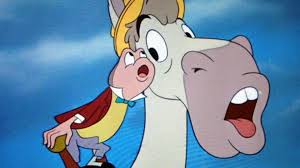
Photo: Disney
As I said above, Disney had planned to develop “The Wind in the Willows” as a full-length film, and that really shows. Animation historian Christopher Finch says that the pacing feels a bit rushed to him, although the animation is fabulous and the characters are fun. His biggest complaint is that he feels that the characters aren’t really as well developed as he would like.
I can see his point, and like I said, I would have loved to have seen the full-length “Wind in the Willows” animated feature. However, I also feel like this short is better than nothing. The animation in “Sleepy Hollow” was also fabulous. The characters don’t really talk, so the animators were able to convey the emotions of the characters and the way the landscape contributes to the fear of the main character.
This piece was part of what enabled Disney to save up enough so he could develop Cinderella, the film that started what I personally think of as the first Disney Renaissance. Technically, The Little Mermaid kicked the “official” Disney Renaissance off in the early 1990s, but I think that, after a period of shorts and some very expensive films that were critically acclaimed but box office duds (I’m looking at you, Bambi, Pinocchio, and Fantasia), the Studio was due for a renaissance and The Adventures of Ichabod and Mr. Toad made it possible for Cinderella to accomplish that.
RELATED: Revisiting Disney: Bambi
This film had as Animation Directors six of the Nine Old Men (Frank Thomas, Ollie Johnston, Milt Kahl, John Lounsbery, Ward Kimball, and Wolfgang Reitherman), with Mark Davis as a character animator (Les Clark and Eric Larson are not present). Mary Blair is also a continued presence in the art and styling department.
SOURCE MATERIAL
Both of these shorts are based on amazing pieces of literature, and both shorts do a remarkable job at conveying the stories. I love how each story begins with the opening of a book that also displays the author’s name and the original story; this was a nice way of paying homage to the original classic while putting the “Disney Spin” on the story.
“The Wind in the Willows” is based on the short novel of the same name written by Kenneth Grahame and published in 1908. Grahame was born in 1859 in Scotland, though due to a family tragedy he spent most of his childhood in Cookham Dene, in England by the Thames. He was a lawyer who loved the outdoors and wrote many short stories which are still beloved today.
The novel is a compilation of bedtime stories and letters written by Grahame to his son, Alastair. In the introduction to the Dalmatian Print Classic Edition, his wife is said to have received the letters from her son’s nurse and kept them, because both women were afraid that Grahame would toss them out. Although “The Reluctant Dragon” is his best-known work, The Wind in the Willows is one of the best-loved books ever written and, according to my copy of the book, has never been out of print.
The story follows Ratty, Mole, Badger and, of course, Mr. Toad, on their adventures in their home along and on the river. Sometimes these adventures are grand and exciting and sometimes, they’re just “messing around on boats” on the river (I know it’s a quote in there, but I can’t remember where).
Overall, it’s an adventure story with heart and an emphasis on how wonderful life can be, in the calm and in the chaos. This short is only a few small parts of the novel and focuses more on Mr. Toad (I always preferred Mole and Ratty), but it still manages to maintain the book’s spirit.
“The Legend of Sleepy Hollow” is based on the short story of the same name written by Washington Irving, an American author. Irving was born in 1783, died in 1859 and his works would inspire such authors as Hawthorne, Longfellow and Melville in some form. Irving traveled extensively in Europe, working as a diplomat.
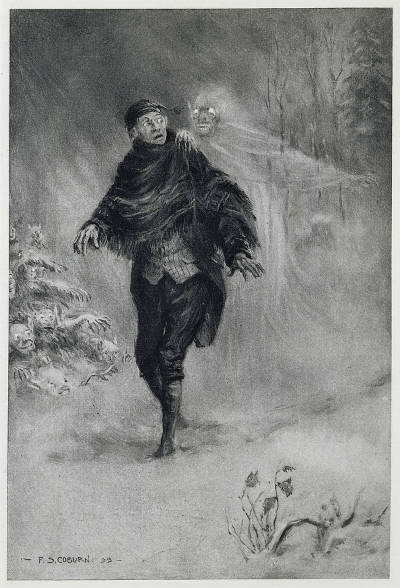
Artist: Frederick Simpson Coburn
Irving’s best-known works are “Rip Van Winkle” and “The Legend of Sleepy Hollow,” both of which take place in upstate and rural New York. “Legend” was published in 1820 as an installment of Irving’s work The Sketch Book, written while he was in England and sent across the pond to be published in America.
“The Legend of Sleepy Hollow” has been remade countless times over the years, and for good reasons; it’s terrifying. This short manages to convey the spirit of the novel and Irving’s classic in a masterful way. Although it also would have been an amazing full-length animated film, I don’t feel as cheated by a shorter “Sleepy Hollow” as I did by the shorter “Wind in the Willows.”
RELATED: TV Reviews: Fox’s Sleepy Hollow
Other versions of “Sleeping Hollow” are also great. Tim Burton’s version (starring Johnny Depp) focuses more on the supernatural aspect of the film, while the modern television adaptation on Fox takes a bit of a “Rip Van Winkle” meets “Sleepy Hollow” meets “Supernatural” approach, with Ichabod waking up in the modern era (I am very fond of the show).
The 1940’s
The 1940s and the anthology films were a clever way for Disney to make films for a lesser price, save up money, and still be producing quality entertainment. As I said last week, the War years, the Disney Strike in the early 1940s and the more expensive films of the early 40s had cost the Studio. They were trying to get back on their feet and these films helped them do that.
Something interesting in these films is the calling back to literature, the American classics and heroes. Like last week, with Johnny Appleseed and Pecos Bill, using Ichabod Crane is a way to call back to the American mythology, maybe to encourage a sense of pride in our nation in a time when things were still a little rough (a World War and the discovery of atomic weapons can do that to you).
The Adventures of Ichabod and Mr. Toad are also fun stories narrated by two of the era’s superstars, providing some escapism from the reality of 1949. The use of these two men gives the public a fun film narrated by two talented actors who call to mind rational thought and deduction (Basil Rathbone as Sherlock Holmes) and delightful escape through music (Bing Crosby).
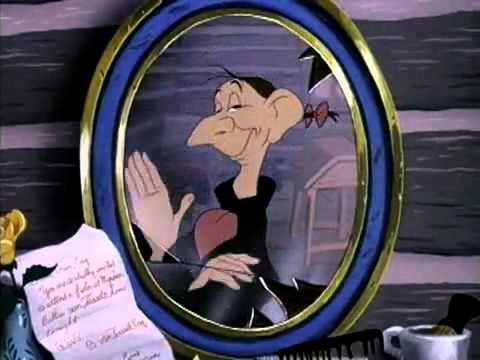
Photo: Disney
LESSONS LEARNED
From Mr. Toad, I learned the danger of fads. Mr. Toad is obsessed with all the latest things; his cart, the motorcar and so on. These fads cause him to lose sight of all his responsibilities and even cause him to give up his prized possessions. It’s a cautionary tale, in some ways, about the dangers of being swept up by new things and forgetting the old ways. New isn’t always better.
Ichabod Crane taught me several things. First, greed has unfortunate consequences. Ichabod wants to marry Katrina, not because he loves her but because she’s pretty and the only heir to a very wealthy man and his farm. Even when Ichabod is dreaming about her, his dreams focus on the material gains (and, if you recall, it doesn’t end up well for him). Additionally, Katrina was using Ichabod to make Brom jealous, and that could have backfired terribly. A lesson from here could have been a reminder that people have feelings (so don’t use them like that!).
Finally, superstitions can be dangerous. Whether or not the Horseman was supernatural or not, even before he appeared Ichabod was terrified at every little sound in the woods. All of this was because of the ghost stories that they were telling at the party, and the scariest ones were only brought up because Brom knew about Ichabod’s fear and superstitions. His superstition kept him in the woods longer and made him more susceptible to whatever happened to him at the end of the short.
DOES IT HOLD UP?
The Adventures of Ichabod and Mr. Toad is, I think, a film that doesn’t get enough credit (this seems to be a trend with the anthology pieces of the 1940s). It was popular enough and successful enough to give Disney the confidence to make a full-length feature. It featured fantastic voice acting and singing, clever animation and truly delightful source material. Altogether, it works and is a fun, although frightening, addition to any Disney collection.
For next week: Cinderella
If you enjoyed this post and the others in the Revisiting Disney series, and have found yourself wishing that you could find them all in one convenient and bound book with eight extra essays, there is an option for you! Check out A Journey Through Disney: My Look Back Through Disney Canon, now available on Amazon as both a Kindle book ($4.99) and a paperback ($11.99).
OTHER SOURCES:
https://thewaltdisneycompany.com/about-disney/disney-history
http://www.imdb.com
http://studioservices.go.com/disneystudios/history.html
Bailey, Adrian. Walt Disney’s World of Fantasy. Everest House Publishers. New York, New York. 1982.
Baym, Nina (General Editor). Norton Anthology of American Literature, Volume B: 1820-1865. W.W. Norton & Company, Inc. New York, NY. 2007.
Dower, John W. War Without Mercy: Race and Power in the Pacific War. Pantheon Books. New York, New York. 1986.
Grahame, Kenneth. The Wind in the Willows.Dalmatian Press Classics. 1908.
Finch, Christopher. The Art of Walt Disney: From Mickey Mouse to the Magic Kingdom. Harry N. Abrams, Inc. New York, New York. 1975.
Sale, Roger. Fairy Tales and After: From Snow White to E.B. White. Harvard University Press. Cambridge, MA, 1978.
Tatar, Maria. The Annotated Classic Fairy Tales. W.W. Norton and Company. New York and London, 2002.
Thomas, Bob. Disney’s Art of Animation From Mickey Mouse to Hercules. Hyperion. New York, New York. 1992.
Wright, Gordon. The Ordeal of Total War: 1939-1945. Harper Torchbooks, Harper & Row. New York, Hagerstown, San Francisco, and London, 1968.
ARE YOU A ROMANCE FAN? FOLLOW THE SILVER PETTICOAT REVIEW:
 Our romance-themed entertainment site is on a mission to help you find the best period dramas, romance movies, TV shows, and books. Other topics include Jane Austen, Classic Hollywood, TV Couples, Fairy Tales, Romantic Living, Romanticism, and more. We’re damsels not in distress fighting for the all-new optimistic Romantic Revolution. Join us and subscribe. For more information, see our About, Old-Fashioned Romance 101, Modern Romanticism 101, and Romantic Living 101.
Our romance-themed entertainment site is on a mission to help you find the best period dramas, romance movies, TV shows, and books. Other topics include Jane Austen, Classic Hollywood, TV Couples, Fairy Tales, Romantic Living, Romanticism, and more. We’re damsels not in distress fighting for the all-new optimistic Romantic Revolution. Join us and subscribe. For more information, see our About, Old-Fashioned Romance 101, Modern Romanticism 101, and Romantic Living 101.

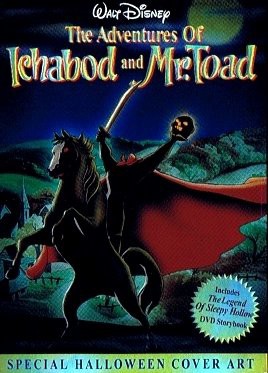

I’ve been revisiting disney myself and have really enjoyed reading your thoughts! thank you!